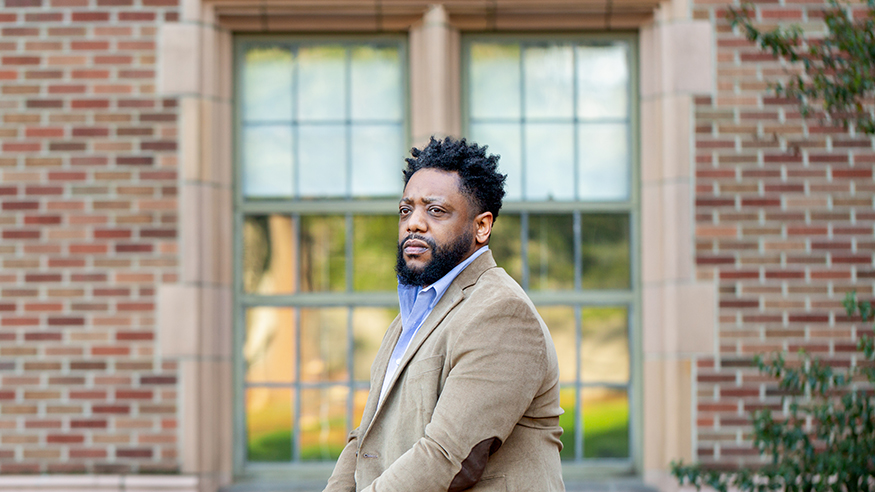
Imagine if technology could identify an individual’s potential for violence long before they caused harm. Would proactive measures be taken? Would the world be safer? Or would such information create new problems?
The 1956 novella “The Minority Report,” and a 2002 film loosely based on it, explore these questions as science fiction, with an innocent man hunted down for a crime he has not yet committed. But current neuroscience research into the “violent brain” — a brain type thought to suggest a risk of violence — brings such science fiction a step closer to reality.
This area of research concerns Oliver Rollins, UW assistant professor of American ethnic studies and author of Conviction: The Making and Unmaking of the Violent Brain (2021, Stanford University Press). The book traces the emergence of neuroscience research on violence and the ongoing social and ethical concerns it raises.
A Fraught History

Thanks to Rollins’ wide-ranging educational interests — an undergraduate degree in biology, a master’s degree in Pan-African Studies, a PhD in sociology, a postdoc at the University of Pennsylvania’s Center for Neuroscience and Society — Rollins interrogates both biological and social scientific perspectives of the “violent brain.” As a Black man, he also is acutely aware that such research could potentially lead to profiling, escalating inequities in society.
Rollins is not the first to raise concerns. Biological studies of violence have a long and fraught history, beginning with research in Italy in the late 19th and early 20th centuries that identified darker skin and larger ear lobes as predictors of violent tendencies. The idea of biological markers for violence gained traction in the US and other countries, and by the 1930s, Adolph Hitler embraced biological criminology as an argument for the annihilation of certain populations. The horrors of World War II led to a pause in such research — but not for long. By the 1960s, studies of the biology of violence resumed.
After all that had happened, why did this research return? Rollins believes advances in psychology were a factor, as psychologists began questioning the ways in which personality is partly biological. Then, as genetics research took hold, scientists began looking for links between genetics and violence. Concerns about this area of research continued to simmer, and reached a boiling point before a 1992 National Institutes of Health conference on genetic factors and violence.
The biology of violence has always been a very controversial area of research. I think the history of this research still haunts scientists today.
“People who understood the history began to ask questions like, ‘Are we simply going back down this road again with genetic factors? Didn’t we already decide there’s no valid reason to think about biological factors in relation to crime?’” Rollins explains. “Others asked, ‘Is this just a back door for you to criminalize more Black people?’”
The controversial 1992 NIH conference was cancelled, but research into the biology of violence continued, with an increased emphasis on objective and “colorblind” approaches.
Objective...or Avoidant?
With the emergence of neuroscience, questions about biology and violence are now being explored with new technology. Researchers continue to claim that their research is colorblind and objective, but Rollins doesn’t buy it.
“This question about biology and violence has always been a racialized and gendered question,” Rollins says. “It has always focused on ‘others’ — those who didn’t fit into the mainstream. When scientists tell me they are objective, I always ask, ‘Why are you asking the questions you’re asking? Your focus on violence isn’t objective — it didn’t fall from the air. It’s something you want to deal with and fix within society. It’s fine that you want to fix something within society, but nothing about that is objective.’”
Rollins interviewed 15 neuroscientists for his book (plus more off the record) after an extensive literature review of neuroscience research on violence from the 1980s through 2014. Convincing researchers to talk about the ethical implications of their work was a challenge.

“Recruiting was hard,” Rollins says, expressing deep appreciation for those who agreed to participate. “The biology of violence has always been a very controversial area of research. I think the history of this research still haunts scientists today.”
Neuroscientists identify the “violent brain” by looking for signs of personality disorders that put an individual at higher risk. Most researchers acknowledge that environmental factors — someone’s upbringing, the life challenges they face — can be instrumental in whether a risk for violence actually leads to violence. Yet they still insist their work is colorblind, despite how race and racism can factor significantly into one’s environment.
Rollins views race as “absent-present” in these scientists’ work – notable for its omission. He recalls one neuroscientist explaining that racism is just “too complex” to put in this model.
“Everything these researchers are doing is trying to guard themselves from having to address questions about race or inequality,” Rollins says. “They don’t want to answer those questions, or any other questions about ethics. But not talking about it doesn’t change the impact of the work.”
A Troubling Future
The impact of this research can already be seen in courtrooms. Though researchers may assert that a biological predisposition for violence does not mean an individual will commit crimes, attorneys are using “violent brain” research in capital cases to argue that their client was biologically susceptible to violence. The potential for the use of similar arguments to criminalize innocent people with “violent brain” characteristics is concerning.
Rollins can imagine a future in which people are surveilled, or even detained, on the basis of their brain scans — science fiction becoming reality. Beyond these concerns, he believes that attempts to address violence through biology are simply misguided, minimizing the outsized impact of one’s social environment on behavior.
“I am not in favor of continuing this research,” he says. “Neuroscientists argue that we haven’t been able to figure out violence within society because we don’t have all the necessary biological information, as if such information would prevent these things from happening. We’ve been down this road before, and it has never led us to answers. We continue to look to these technologies to solve violence, but I believe they are never going to be able to get us there.”
More Stories

A Healing Heart Returns
In February, the UW Symphony will perform a symphony that Coast Salish elder Vi Hilbert commissioned years ago to heal the world after the heartbreak of 9/11. The symphony was first performed by the Seattle Symphony in 2006.

The Public Impact of Private Cities
Geography major Edwin Bai has researched private cities, developed by individuals and corporations, that "take the libertarian idea of low government regulation to the maximum."

Coast Salish Traditions are "Woven in Wool" at the Burke
A Burke Museum exhibit, co-curated by Coast Salish weavers and Burke curators, highlights the importance of weaving to Coast Salish communities.
